- This topic has 5 replies, 2 voices, and was last updated 4 years, 7 months ago by
 Bill Ward.
Bill Ward.
-
AuthorPosts
-
11 April 2021 at 3:04 pm #574941
 Alex PrattParticipant
Alex PrattParticipantAfter the low meteor rates in February and March, the Lyrid meteors provide a welcome increase in activity, although don’t expect too much from them; they usually produce a peak ZHR of ~20 meteors per hour. Lyrids are debris from the long-period comet C/1861 G1 Thatcher and the Earth passes through this dust every April, generally putting on a display from the 14th until the end of the month. Here is their activity profile from NEMETODE’s multi-year video data:
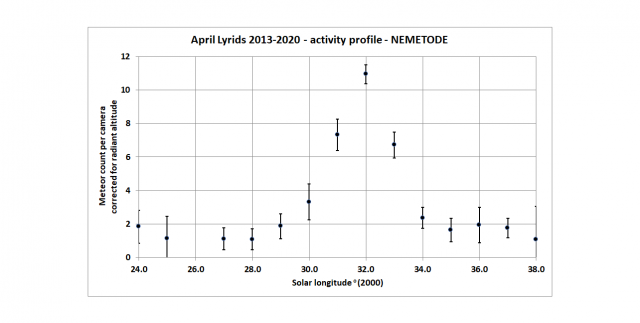
(The x-axis is presented in units of solar longitude, which is used by meteor workers rather than the civil calendar). The plot displays a peak at 32o, which equates to 2021 April 22 05h UT. Grouping the data into bins of 0.25o solar longitude around their peak gives this profile:
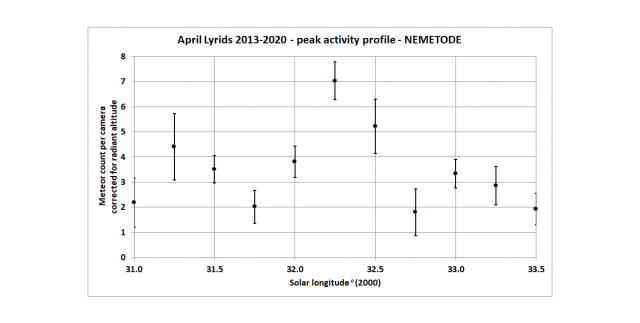
further refining it to occur around 32.25o, 2021 April 22 11h UT, in good agreement with the IMO and other sources. Note that these plots are derived from multi-year video data, which tends to smooth out any annual variations. They suggest that we can expect fairly good rates on the nights of April 21/22 and 22/23.
The Lyrids appear from a radiant just southwest of Vega and they are medium-speed meteors with geocentric velocities (Vg) of 47 km/s. The Moon reaches First Quarter on April 20, so it could be a nuisance during visual watches or DSLR photography. Video should be relatively unaffected. Please report your observations to the Meteor Section
Clear skies,
Alex.
22 April 2021 at 8:40 pm #584116 Bill WardParticipant
Bill WardParticipantHi,
Looking at the radio plots the predicted time of the peak from the graphs looks to be pretty good!
Overall activity seemed to be quite low this year. Didn’t record a single confirmed Lyrid spectrum. However I did record a super spectrum from what is looking like a sporadic (Although this may change, Alex et al have started to analyse the orbit…)
I recorded the meteor on several systems.
This is the zero order image on one of the ZWO cameras:
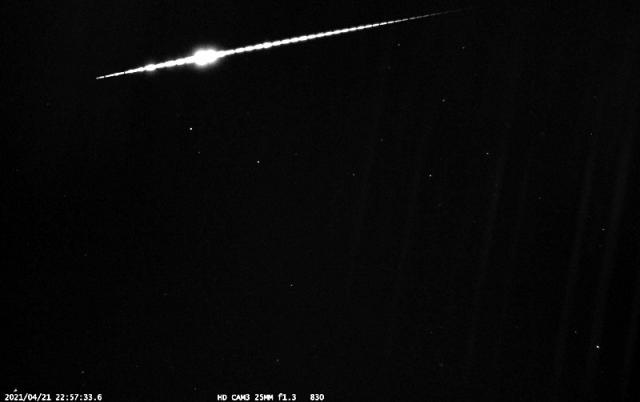
The spectrum from another ZWO camera:
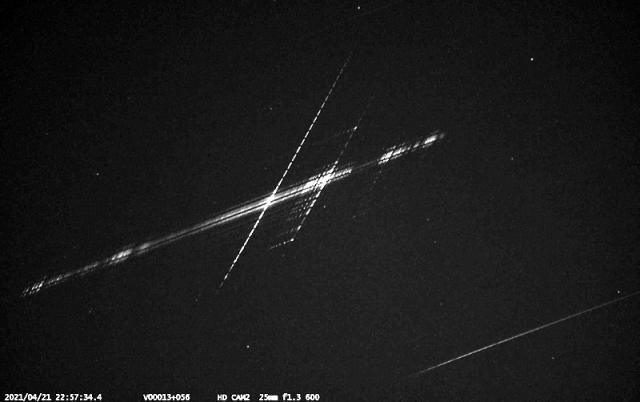
An instrument corrected plot:
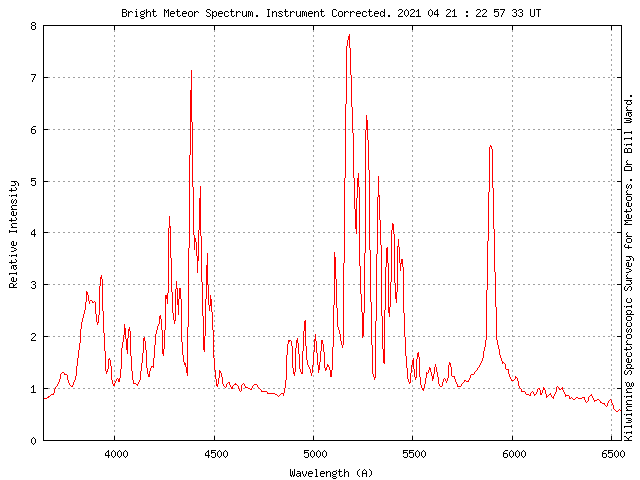
…and finally my usual colourised synthetic spectrum…

The “longest” line in the spectrum image is sodium, very strong, but also very strong emission from Mg and plenty of Fe lines.
Little or no near IR atmospheric lines so probably relatively slow Vg, interestingly, and as as a possible consequence of the low Vg there are no (or very weak) ionised Ca on ionised Mg lines.
Not a Lyrid but lovely!
Cheers,
Bill
22 April 2021 at 10:57 pm #584117 Bill WardParticipant
Bill WardParticipantWhilst processing the spectrum I had a funny feeling that this looked familiar somehow….
Couldn’t quite put my finger on it, then I got it!
A while back I was asked to look at, what was then a mystery spectrum, taken by Ed Majden in June 1997 from Canada.
A little cropping to give a better comparison. This is the flare section from the meteor last night.

…and this is Ed’s spectrum from 1997, also cropped on one of the flares…

Remarkably similar morphology!
24 April 2021 at 2:50 pm #584121 Alex PrattParticipant
Alex PrattParticipantHi Bill,
Thanks to data from NEMETODE members David Anderson (Dunure), Denis Buczynski (Tarbatness) and William Stewart (Ravensmoor) we can confirm the following: Its ground track
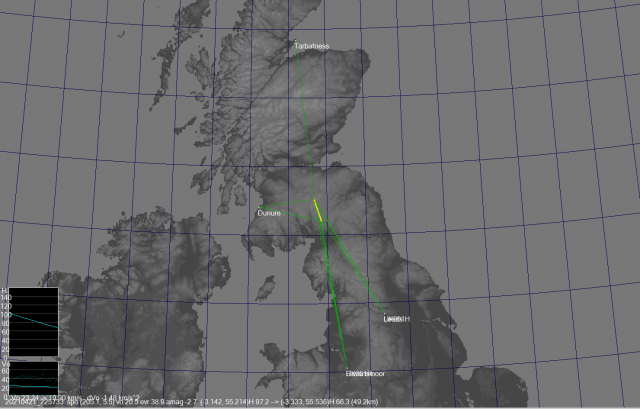
showing it travelled approximately S to N, descending from 97 km altitude to 66 km. It had an absolute mag. of about -3.
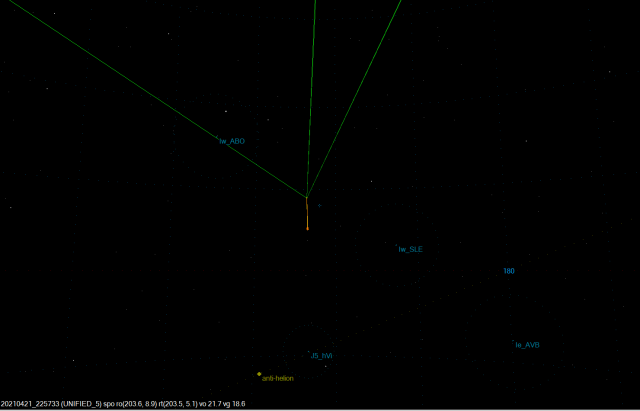
Its radiant was at RA 13h 34m, Dec 5.1, amongst the Virginid / antihelion source. Its Vg was slow, ~18.5 km/s – confirming your assessment!
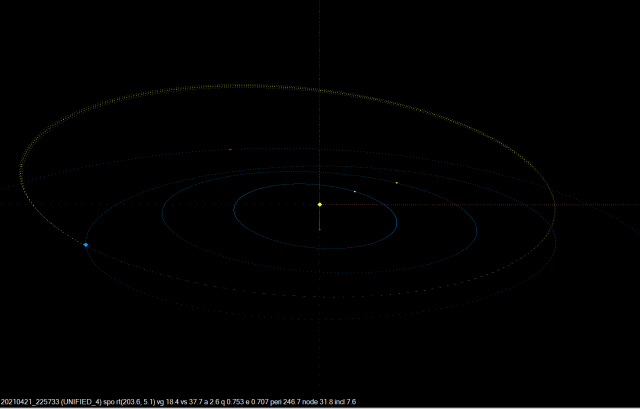
We have a Q3-quality solar system orbit which is very similar to the alpha Virginid (AVB) stream.
Cheers,
Alex.
26 April 2021 at 6:26 pm #584125 Bill WardParticipant
Bill WardParticipantHi,
That is a super result. Well done everyone!
I’m glad my guesstimate about the Vg was correct ; – )
One of those “secondary” results that a spectrum can reveal…
Cheers,
Bill.
PS
I had a look at what Ed sent me in 2019. He says he estimated that the meteor was -4, also very similar to the -3 here. Yep, this is an interesting one…
10 May 2021 at 9:29 pm #584193 Bill WardParticipant
Bill WardParticipantHi,
The devil is in the detail, as they say.
There are definite lines visible longward of the sodium line in the first spectrum plot here and closer inspection reveals quite a few more.
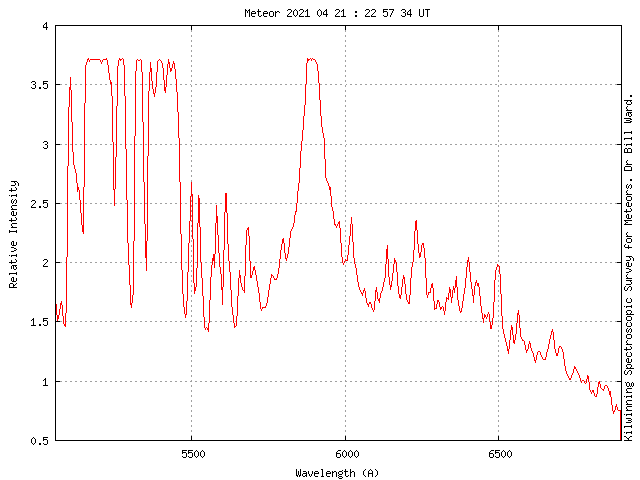
With some stretching there are some 17 “real” lines just above the noise in the original image. I’m still trying to identify these. I’m confident some are W but as for the rest….
There are a few lines in this part of the spectrum in a lot of spectra I’ve captured. I’ve attributed these to weak Fe and Ca but I’ve never captured so many others. The relatively slow velocity of this meteor might be revealing some very interesting features. Work done by Jiri Borovicka on what he calls “the orange band” indicates that some of these line may actually be oxides. This will take more study but this is by far the most interesting spectrum I’ve captured.
Cheers,
Bill.
-
AuthorPosts
- You must be logged in to reply to this topic.
